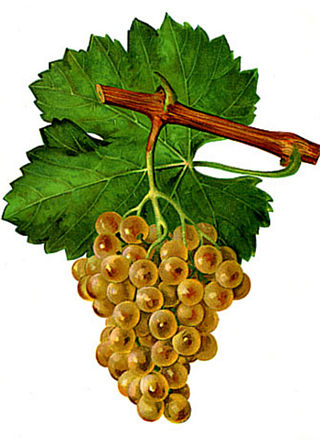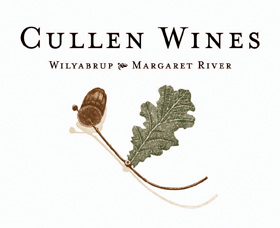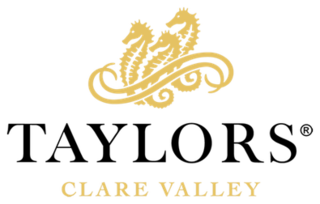
The Canberra District wine region is located around Canberra in the Capital city of Australia. It covers the northern part of the Australian Capital Territory and an area of New South Wales to the east and north of that, including towns of Bungendore, Murrumbateman and Yass, New South Wales.

Sémillon is a golden-skinned grape used to make dry and sweet white wines, mostly in France and Australia. Its thin skin and susceptibility to botrytis make it dominate the sweet wine region Sauternes AOC and Barsac AOC.

Bordeaux wine is produced in the Bordeaux region of southwest France, around the city of Bordeaux, on the Garonne River. To the north of the city, the Dordogne River joins the Garonne forming the broad estuary called the Gironde; the Gironde department, with a total vineyard area of 110,800 hectares, is the second largest wine-growing area in France behind the Languedoc-Rousillon.

Ridge Vineyards is a California winery specializing in Cabernet Sauvignon, Zinfandel, and Chardonnay wines. Ridge produces wine at two winery locations in northern California. The original winery facilities are located at an elevation of 2,300 feet on Monte Bello Ridge in unincorporated Santa Clara County in the Santa Cruz Mountains AVA, south of Los Altos, California and west of Cupertino, California. The other Ridge winery facilities are at Lytton Springs in the Dry Creek Valley AVA of Sonoma County. Ridge Vineyard's 1971 Monte Bello Cabernet Sauvignon gained prominence for its fifth-place finish in the 1976 "Judgment of Paris" wine tasting.

The Australian wine industry is one of the world's largest exporters of wine, with approximately 800 million out of the 1.2 to 1.3 billion litres produced annually exported to overseas markets. The wine industry is a significant contributor to the Australian economy through production, employment, export, and tourism.

New Zealand wine is produced in several of its distinct winegrowing regions. As an island country in the South Pacific Ocean, New Zealand has a largely maritime climate, although its elongated geography produces considerable regional variation from north to south. Like many other New World wines, New Zealand wine is usually produced and labelled as single varietal wines, or if blended, winemakers list the varietal components on the label. New Zealand is best known for its Marlborough Sauvignon Blanc, and more recently its dense, concentrated Pinot Noir from Marlborough, Martinborough and Central Otago.

Brown Brothers Milawa Vineyard is a family-owned wine company based in Milawa, Victoria, Australia. Brown Brothers was founded in 1889 by John Francis Brown and continues to be owned and operated by his descendants on the original property. Brown Brothers makes wine from a wide range of grape varieties and into a range of styles.

The South Australian wine industry is responsible for more than half the production of all Australian wine. South Australia has a vast diversity in geography and climate which allows the state to be able to produce a range of grape varieties–from the cool climate Riesling variety in the Clare Valley wine region to the big, full bodied Shiraz wines of the Barossa Valley.

New South Wales wine is Australian wine produced in New South Wales, Australia. New South Wales is Australia's most populous state and its wine consumption far outpaces the region's wine production. The Hunter Valley, located 130 km (81 mi) north of Sydney, is the most well-known wine region but the majority of the state's production takes place in the Big Rivers zone-Perricoota, Riverina and along the Darling and Murray Rivers. The wines produced from the Big Rivers zone are largely used in box wine and mass-produced wine brands such as Yellow Tail. A large variety of grapes are grown in New South Wales, including Cabernet Sauvignon, Chardonnay, Shiraz and Sémillon.

Howard Park Wines are Margaret River and Great Southern wine specialists and a family-owned winery owned by the Burch family, which is responsible for such brands as Howard Park, MadFish, and Marchand & Burch. With an established winery based in Margaret River, Western Australia and vineyards in the Great Southern, the Burch family are the first Australians to gain ownership in the production of a French Burgundian Grand Cru.

A screw cap is a metal, normally aluminium, cap that screws onto threads on the neck of a wine bottle, generally with a metal skirt down the neck to resemble the traditional wine capsule ("foil"). A layer of plastic, cork, rubber, or other soft material is used as wad to make a seal with the mouth of the bottle. Its use as an alternative to cork for sealing wine bottles is gaining increasing support. In markets such as Australia and New Zealand screw caps on bottles have overtaken cork to become the most common means of sealing bottles.

Henschke is a family-owned, 156-year-old Australian winery, located in Keyneton, South Australia in the Eden Valley wine region. It produces the 'Hill of Grace', one of Australia's "cult wines", and was considered Australia's second best wine by James Halliday in 2009.

The Barossa Valley wine region is one of Australia's oldest and most premier wine regions. Located in South Australia, the Barossa Valley is about 56 km northeast of the city of Adelaide. Unlike most of Australia whose wine industry was heavily influenced by the British, the wine industry of the Barossa Valley was founded by German settlers fleeing persecution from the Prussian province of Silesia. The warm continental climate of the region promoted the production of very ripe grapes that was the linchpin of the early Australian fortified wine industry. As the modern Australian wine industry shifted towards red table wines in the mid-20th century, the Barossa Valley fell out of favor due to its reputation for being largely a Syrah from producers whose grapes were destined for blending. During this period the name "Barossa Valley" rarely appeared on wine labels. In the 1980s, the emergence of several boutique families specializing in old vine Shiraz wines began to capture international attention for the distinctive style of Barossa Shiraz, a full bodied red wine with rich chocolate and spice notes. This led to a renaissance in the Barossa Valley which catapulted the region to the forefront of the Australian wine industry.
Clonakilla is an Australian winery based in the Canberra wine region of Murrumbateman, New South Wales.
Giaconda is an Australian winery in Beechworth, Victoria.
Leeuwin Estate is an Australian winery and restaurant based in the Margaret River wine region of Western Australia.

Cullen Wines is an Australian winery based in Wilyabrup, within the Margaret River wine region of Western Australia.

Taylors Wines is a family-owned winery established in 1969 and located in the Clare Valley of South Australia. Taylors is one of the founding members of the Australia's First Families of Wine. As at 2022 it was ranked the thirteenth largest Australian wine company in terms of total revenue.

Red Willow Vineyard is a grape-growing estate located in the far western end of Yakima Valley AVA, within the Yakama Indian Reservation. Beginning with their relationship with Columbia Winery and Master of Wine David Lake, grapes from Red Willow have been used to produce some of the most critically acclaimed Washington wines with the vineyard's name regularly being featured on vineyard designated wines. Paul Gregutt, wine writer for the Seattle Times and Wine Enthusiast, list Red Willow as one of the "top ten" vineyards in the entire state.

Deep Woods Estate is an Australian winery at Yallingup, in the Margaret River wine region of Western Australia.

















